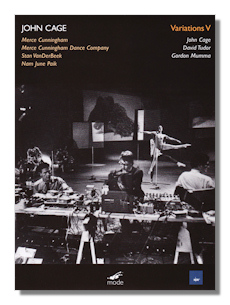
The Internet's Premier Classical Music Source
Related Links
- Cage Reviews
- Latest Reviews
- More Reviews
-
By Composer
-
Collections
DVD & Blu-ray
Books
Concert Reviews
Articles/Interviews
Software
Audio
Search Amazon
Recommended Links
Site News
 DVD Review
DVD Review
John Cage

Variations V
Complete John Cage Edition, Volume 48
- Variations V, NDR Studio Film
- PCM Audio: 1966 Performance of Variations V
- Interview: David Vaughan, Merce Cunningham Dance Company Archivist with Dancers
John Cage
David Tudor
Gordon Mumma
Merce Cunningham Dance Company, Merce Cunningham
Mode 258 DVD Region 0 NTSC 4:3/16:9
Cage's work in the 1960s recognized the vital new role that technology was already playing (and would come to play) in artistic expression in general, and music in particular. Tape, light, (relatively) easy control of sound and sight in performance; the admixture of these to "conventional" compositional techniques; and the resulting evidence that the sum of such a multimedia, multidisciplinary work as Variations V would always be greater than its parts.
Those parts, those aural and visual components, were taped sound (much of it apparent random and white "noise" (though always gentle, controlled), processed spoken word, multiple vaguely symbolic objects, back projection, superimposition of symbol, scene and sequence – both familiar and unfamiliar. And dance. Variations V is a homogeneous work, 40 minutes long, which does indeed combine Cage's music (not a conventionally melodious "score") with the choreography of Cage's partner, Merce Cunningham. Although performed worldwide at the time, filmmaker Stan VanDerBeek teamed with projection and "effects" specialist Nam June Paik as part of the creative multimedia team which supplied the filmed and still image projections in the backdrops and overlays for a filmed performance in 1966 at the NDR television studio in Hamburg. One of the few (remaining/surviving) films of a Merce Cunningham Dance Company, this DVD is a record, Yes, of a single event. But it's presented by Mode in such a way that the context and the historical significance of this aspect of Cage's work are almost as important. It shows just how vital to Cage directed experiment was; and an almost complete deconstruction of what makes a work of art.
Those who don't/didn't know what to expect from Cunningham will/would probably have been surprised by the choreography. By the fact that the dancers' actions and positions on stage electronically determined the content of the sound and projected visual experience. But, one hopes, they'll understand and be inspired by Cage's vision of inventing and executing a totally collaborative work which – as this DVD amply shows – thoroughly integrates music and sound, kinesthetics and movement, video and visual stimuli.
This extraordinary and invaluable DVD from Mode ironically captures another attribute of Cage's work at this time: the notion that music, art must no longer be tethered to the finished object, complete performance or the mounting of occasions with aspirations to the definitive. Rather, we get more out of our engagement by acknowledging – by celebrating – its status as an environment under development. Indeed, in the lengthy and illuminating interviews with Carolyn Brown by David Vaughan which are also featured on the DVD says she preferred the rehearsals to the actual "performance".
Not that the performances of Variations V could ever be mistaken for an amateurish mishmash of son and lumière. They're full of a restrained energy, of a calm knowledge that something significant and important was happening as Cage's collaboration with Cunningham, Mumma and Tudor evolved. Knowing just in how many ways Variations V were performed subsequently (the booklet that comes with the DVD lists almost 22 in the 1960s) helps us understand which forces worked – and how they worked. The variations reveal the common threads, the essences.
This DVD is as much a historical document as it is a record of a major work by Cage from almost half a century ago. Vaughan's interviews also reveal just how "spontaneously" Cunningham and his team (purely technical… electricians, riggers, engineers; and musicians, dancers, performers) worked. Contemporary notes which Carolyn Brown reads suggest, if not conflict between Cunningham and his team, a fair degree of disorganization and unpreparedness. Charitably, one would react to this (now) by labeling as "indeterminate" unplanned and inconsistent dance moves and effects – especially with the "props" (bicycles, chairs, pot plants and so on) that are so integral to the work – and hence seeing them as consistent with Cage's vision.
Also on the DVD is a stereo audio (PCM) track of Variations V. Although it must not be forgotten that (for Cage, surely) the work should be seen in its own right as something worth engaging with, the concise and focused booklet written by Rob Haskins with notes by Mumma himself and Michelle Fillion (Canadian musicologist, and Professor of Music at the University of Victoria, British Columbia) emphasizes Cage's role in the work: Variations V was one of eight such numbered pieces with – typically – no conventional score; only written instructions which outlined the work's conception. Although the booklet contains a brief bibliography, (extracts from) Cage's writing would have been useful here. Nevertheless, this DVD is one which not only aficionados of Cage, but also those curious about just how vibrant musical experimentation was in the 1960s, will want to own.
Copyright © 2013, Mark Sealey




















